Activity: Ethanol Fermentation
 (Activity courtesy of Newton’s Apple, PBS TPT Saint Paul/Minneapolis) Grade level: 9-12.
(Activity courtesy of Newton’s Apple, PBS TPT Saint Paul/Minneapolis) Grade level: 9-12.
Overview
What kinds of foods are easiest to ferment for fuel? Ethanol is made from a variety of plant substances – corn, sugar cane, even some kinds of wood. In this activity, students will test different substances to see what they can learn about fermentation.
Background
As the number of people in the world keeps growing, so does our need for energy. Some energy sources, specifically fossil fuels like coal and oil, are in limited supply. Once we use up what’s in the ground, they will be gone forever. Other energy sources, such as wind, water power, and solar energy, are called renewable energy, because they will regenerate over and over again as we use them.
Ethanol is one form of renewable energy that is becoming widely used. Ethanol is a form of alcohol that can be burned in engines just like gasoline. But, unlike gasoline, which is made by distilling crude oil, ethanol is made from the starchy parts of plants. Most ethanol in this country is created through fermentation of corn. Microscopic yeast cells break down the starch and water, creating ethanol and carbon dioxide gas.
In addition to being a renewable fuel, ethanol helps to reduce air pollution. When anything burns in air, molecules of that substance combine with oxygen. Gasoline is a substance made of carbon and hydrogen. When it burns, some, but not all, of the carbon atoms combine with oxygen to make carbon dioxide (CO2). Hydrogen in the gasoline combines with more of the air’s oxygen to make water (H2O). There isn’t enough oxygen left to combine with the remaining carbon atoms. Deadly carbon monoxide gas (CO) is the result. Like gasoline, ethanol is made of carbon and hydrogen, but in addition it contains its own supply of oxygen. When ethanol burns with gasoline, its “extra” oxygen atoms combine with the “extra” carbon atoms to reduce or even eliminate CO in the exhaust gases.
In some parts of the U.S., ethanol is mixed with gasoline at 1 part ethanol to 9 parts gasoline to help reduce air pollution. No adjustment is needed for a car’s engine to burn this mixture. Some new cars are designed to burn fuel blends of up to 80 percent ethanol. Yet, ethanol costs more to make than gasoline, even though new production technologies may bring the price down in the coming years. Another disadvantage is that a gallon of ethanol doesn’t hold as much chemical energy as a gallon of gasoline. So, though ethanol burns more cleanly than gasoline, a car won’t go as many miles per gallon.

Materials
- 8 (or more) packets of yeast
- 4 clear glass, half-liter containers
- stirrers
- measuring spoons
- flour, salt, sugar, vinegar
- heating element
Procedure
Part One – Fermenting Foods
1. Empty one packet of yeast into each of four half-liter (one pint) beakers of warm water. Stir for one minute.
2. Add 10 ml (2 tsp) of flour to each beaker. Stir again.
3. Add 5 ml (1 tsp) of salt to the first beaker, 5 ml of sugar to the second beaker, 5 ml of vinegar to the third, and leave the fourth alone. Stir again.
4. Wait 5 minutes. What do you observe? Record your observations.
5. Wait 15 minutes. What do you observe? Record your observations.
6. Let the solutions sit overnight. What do you observe? Record your observations.
Questions
1. What is the evidence that reactions are going on in any of the containers? How are these observations related to fermentation?
2. Can you draw any conclusions about which of the substances tested was most helpful to yeast fermentation?
Part Two – Changing Temperatures
 1. In this part of the activity, you will observe the effect of different temperatures of water on fermentation. The teacher will prepare boiling water for the first beaker. Fill the second beaker with warm water – just a little warmer than skin temperature. Fill the third beaker with cold tap water. Fill the fourth beaker with ice water.
1. In this part of the activity, you will observe the effect of different temperatures of water on fermentation. The teacher will prepare boiling water for the first beaker. Fill the second beaker with warm water – just a little warmer than skin temperature. Fill the third beaker with cold tap water. Fill the fourth beaker with ice water.
2. Empty one packet of yeast into each beaker. Stir to dissolve. Add 10 ml of flour and 5 ml of sugar to each jar. Stir again.
3. Wait 5 minutes. What do you observe? Record your observations.
4. Wait 15 minutes. What do you observe? Record your observations.
Questions
1. Were there any conditions under which the fermentation didn’t seem to proceed or went only very slowly? What were they? Can you think of explanations for these results?
2. Can you draw any conclusions about what temperature is best for yeast-flour-sugar fermentation? Try many different combinations of yeast and food and temperatures. What is the optimum mixture for fermentation?
Extension
Debate the issues: though some believe that ethanol is a promising alternative fuel source, others are concerned about the costs of its production — financial, as well as in terms of environmental impact. Students can be assigned to research the question and give a brief report, either orally or in written form. The class can then choose sides and prepare arguments for a formal debate. They can use the resources listed below to get started
Resources/Sources
The U.S. Department of Energy, ABC’s for Biomass
Institute for Local Self-Reliance
Halperin, Alex. “Ethanol: Myths and Realities” Business Week (May 19, 2006)
“All About Ethanol” from the American Coalition for Ethanol.
Filed under: Class Activities, Grades 9-12
Tags: Agricultural, Alternative Energy, Alternative Fuels, Class Activities, Environmental Engineering, Grades 9-12, Green Technology








